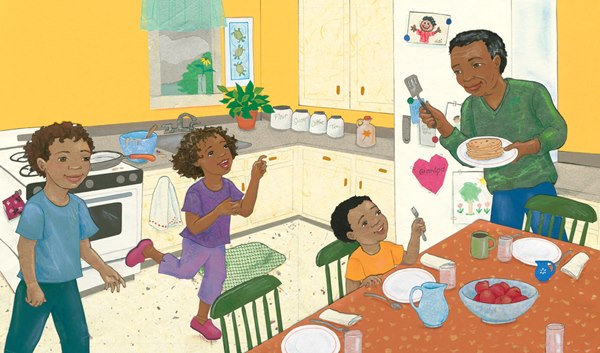Every time we visit the dentist, the hygienist asks how often we  floss. We all know the correct and only answer is “every day.” We squirm under the light as we try to come up with an answer that gets us as close to saying “every day.” We leave feeling guilty and promise this is the year to change only to find ourselves in the same spot six months later.
floss. We all know the correct and only answer is “every day.” We squirm under the light as we try to come up with an answer that gets us as close to saying “every day.” We leave feeling guilty and promise this is the year to change only to find ourselves in the same spot six months later.
This uncomfortable, familiar exchange reminds me of a lot of the conversations with parents about home reading habits at parent-teacher conferences. After each assessment cycle throughout the year, I would ask parents how reading was going on at home (outside of daily homework).
 They knew this conversation was coming. I knew it was coming. They knew the right answer is “every day” and like a hygienist peering into a patient’s mouth, I had an educated guess on how often the child was actually reading at home based on progress in class.
They knew this conversation was coming. I knew it was coming. They knew the right answer is “every day” and like a hygienist peering into a patient’s mouth, I had an educated guess on how often the child was actually reading at home based on progress in class.
Just 20 minutes a day! I would list the benefits and show the charts (here and here and here and here and here). I would point out that one cartoon episode is 30 minutes (24 minutes without commercials!). Parents know how important it is—no one disagrees—and we would all nod earnestly and vigorously with promises to start this very night.
Yet, it is hard. Schedules are tight and unforgiveable. Children (and parents!) are tired at the end of the day.
Let’s face some facts:
- Both parents and children agree strong reading skills are among the most important skills children should have.
- Reading is one of the most popular resolutions for both parents and children.
- Half of all New Year’s resolutions fail within six months.
- Some parents need to expose their children to a new vegetable 10 or more times before they’ll consider trying it (point being: children aren’t always easy to work with).
- Even adults take 66 days on average to start a new habit (and more to break an old one).
Mind-blowing insight alert: Creating new habits takes time and persistence.
How do we make daily reading with children engaging, manageable, and achievable?
1. Start with bite-size steps. You don’t have to raise your child’s literacy level, knowledge base, or vocabulary by next week. Remember the end game: To create curious, book-loving readers. Starting a reading routine at home is about creating a lifelong habit for your family and children. Aim to improve your family’s daily reading routine for just the next eight weeks (by the following parent-teacher conference in March or May), instead of this year’s resolution to be reading every day for the rest of your child’s K-12 education (a bit daunting, no?).
2. Redefine what a reading routine looks like. Adjust what reading time is for your family based on your child’s age, reading level, energy level, and interest:
- You read the story to your child
- You alternate reading together by page, chapter, or day
- Your child reads to you and a younger sibling
- You download the audio book version and follow along in the book together
- You both read with your own copy silently side by side for the 20 minutes and discuss afterward
As Tim Gunn says, “Make it work.”
 3. Make reading “spill over.” Choose a book with an additional tie-in to other parts of the day and your family’s interests:
3. Make reading “spill over.” Choose a book with an additional tie-in to other parts of the day and your family’s interests:
- If there is a new movie or community theater’s play coming out based on a book, read the book first and then reward yourselves with the movie or play.
- Pick a fairy tale to read and find additional versions in both book and movie form to compare. Hello, Cinderella!
- Follow up with a readers’ theater script to pair with the story. I can’t get enough of the readers’ theater scripts from California Young Reader Medal.
- If the book includes a craft, science experiment, or recipe at the end, read the story and then extend the learning into the garage or kitchen. This is great for whole family participation.
- Pair a current event or news article with a book on the same topic, culture, or time period.
4. Only pick books and formats your child loves or is interested in. Reading at home should not be boring, a chore, a punishment, or part of homework. Don’t pick books assigned in class, books that peers all seem to be reading, or books you think your child should be reading. This is about enjoyment, building interest, and creating memories. With this in mind, books come in all types/reading comes in all forms:
- Toy instruction manuals or activity/craft books
- Cookbooks—recipes are great for re-reading!
- Poetry collections
- E-readers (Note: Just be sure to pick a program that presents the story to the child as a book, not just as a cartoon where the music and animation effects can distract from the words and vocabulary.)
- Graphic novels and comic books—read about how Lee & Low publisher, Jason Low, became an avid reader after getting hooked on his first comics!
Better yet—let your child choose for maximum engagement.
5. Don’t cry over skipped reading. For whatever reason, reading time just didn’t happen one night. Whoops! Just read the next day and perhaps add a few minutes on extra. Any time is better than none at all. Remember you are trying to show that we read for enjoyment, not punishment. Every day you read with your child is a win—one skipped day doesn’t undo all the progress you have made together.
6. Do over think it—please! If you are finding it difficult to stick with reading 20 minutes a day with your child, think about where the obstacle is. Are nights too busy? Do transit or errands take time away from family downtime? Do you get home too late? Reading at breakfast or on the bus/subway, engaging grandparents and older siblings, trying 10 minutes in the morning and 10 minutes at night may help your family stick with the reading routine.
7. Join a community. You are not the first or last parent to a) struggle to inspire your child to read b) find time to read or c) make reading time exciting. There are wonderful experts with research, reading tips, and inspiration available. Some of my favorite parent reading newsletters are National Center for Families Learning, ¡Colorín Colorado!, Reading Rockets, and Zoobean.
The Number One Most Important Thing:
Every time you read with your child is a win. Every time you skip is a lost opportunity, but it won’t doom your child. Remember the end goal: To support our children’s lifelong love of reading (increased knowledge/vocabulary will be a bonus). Keep at it.
Here’s to a great year of reading and growing!
 Jill Eisenberg, our Senior Literacy Expert, began her career teaching English as a Foreign Language to second through sixth graders in Yilan, Taiwan as a Fulbright Fellow. She went on to become a literacy teacher for third grade in San Jose, CA as a Teach for America corps member. She is certified in Project Glad instruction to promote English language acquisition and academic achievement. In her column she offers teaching and literacy tips for educators.
Jill Eisenberg, our Senior Literacy Expert, began her career teaching English as a Foreign Language to second through sixth graders in Yilan, Taiwan as a Fulbright Fellow. She went on to become a literacy teacher for third grade in San Jose, CA as a Teach for America corps member. She is certified in Project Glad instruction to promote English language acquisition and academic achievement. In her column she offers teaching and literacy tips for educators.








